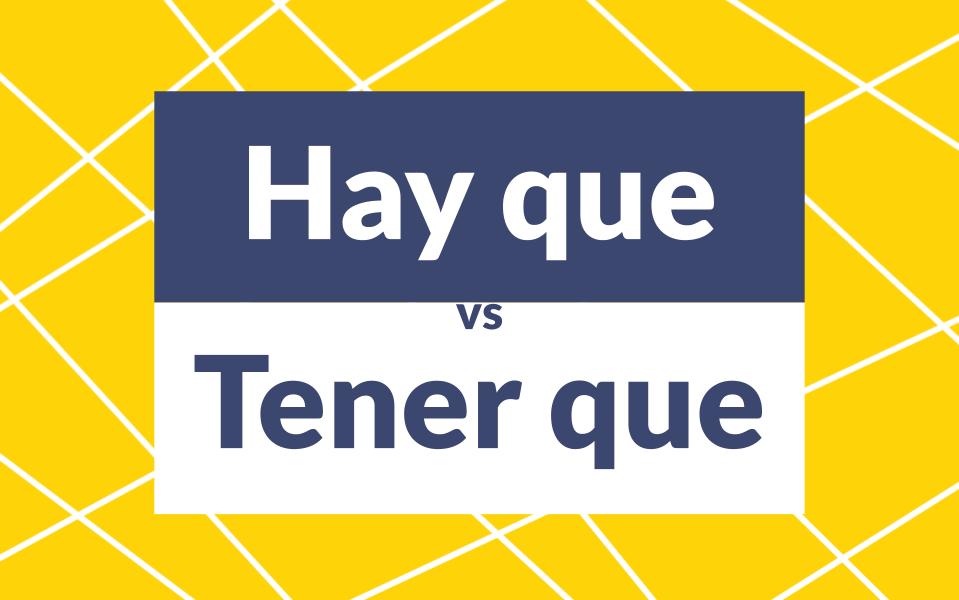Hay que vs Tener que: Expressing obligation in Spanish

Get our free email course, Shortcut to Conversational.
Have conversations faster, understand people when they speak fast, and other tested tips to learn faster.
More infoHay que and tener que are expressions Spanish speakers use to communicate obligation, necessity, commitment, or to give instructions. Tener que and hay que in English can both be translated as to have to or to need to.
Although these expressions both have the same function in Spanish, there is a difference between them. The expression hay que is impersonal. By that, we mean that we don’t conjugate hay que to a specific subject. It rather expresses a general obligation, without naming someone in particular that must fulfill that obligation. With tener que, on the other hand, the subject who needs to fulfill the obligation is always clear.
In this post we’ll cover all the details of these two expressions so you’re comfortable choosing between hay que vs tener que. We’ll go over how to use each one, and introduce the nuances of each. We’ll even compare these with another synonym for “must” or “to have to” in Spanish: deber.
Tener que
Tener que is our first expression for stating obligation in Spanish, translating best as “to have to” in English.
Just like the English expression which is built on the verb “to have,” tener que is built on the Spanish verb “tener,” which translates directly as “to have” in Spanish.
Similarly to the English version, we also follow tener que with another verb in its infinitive form to say that we have to do that action. In other words, the construction is always: tener que + infinitive.
With tener que, the verb tener will always be conjugated to match the subject: the person who has to do something. So to use tener que, we just choose the tense and subject and add the next verb in its infinitive form.
Tener que conjugation
Before we see any examples of tener que in use, let’s review its conjugations in the most common tenses. We’re showing the full tener que conjugation for eight tenses here, though if you’re looking for additional tenses you can always refer to a tener conjugation chart and just add que.
| Subject | Present | Imperfect | Preterite | Future |
| Yo | tengo que | tenía que | tuve que | tendré que |
| Tú | tienes que | tenías que | tuviste que | tendrás que |
| Él, Ella, Usted | tiene que | tenía que | tuve que | tendrá que |
| Nosotros, Nosotras | tenemos que | teníamos que | tuvimos que | tendremos que |
| Vosotros, Vosotras | tenéis que | teníais que | tuvisteis que | tendréis que |
| Ellos, Ellas, Ustedes | tienen que | tenías que | tuvieron que | tendrán que |
| Subject | Conditional | Present Perfect | Pluperfect | Present Subjunctive |
| Yo | tendría que | he tenido que | había tenido que | tenga que |
| Tú | tendrías que | has tenido que | habías tenido que | tengas que |
| Él, Ella, Usted | tendría que | ha tenido que | había tenido que | tenga que |
| Nosotros, Nosotras | tendríamos que | hemos tenido que | habíamos tenido que | tengamos que |
| Vosotros, Vosotras | tendríais que | habéis tenido que | habíais tenido que | tengáis que |
| Ellos, Ellas, Ustedes | tendrían que | han tenido que | habían tenido que | tengan que |
Tener que + infinitive: Examples
Now let’s put this lesson into action, using the right tener conjugation for each subject who is obligated to do the following action. We’ll bold the tener que phrase in both languages, and let you take note of the verbs that follow using the construction of tener que + infinitive.
- To feel better you have to eat healthily. – Para sentirte mejor tienes que comer saludable.
- Yesterday, I took the final history exam. I had to study a lot. – Ayer presenté el examen final de historia. Tuve que estudiar mucho.
- I lost my job, so we’ll have to cut expenses. – Perdí mi empleo, entonces tendremos que recortar los gastos.
- I just got back from the gym, I need to take a shower. – Acabe de llegar del gimnasio, tengo que tomar una ducha.
- María needs to buy a new pair of sneakers. The ones she has are already old. – María tiene que comprar un par nuevo de tenis. Los que tiene ya están viejos.
- I can’t go, I have to take my father to the airport. – No puedo ir, tengo que llevar a mi padre al aeropuerto.
- Get up now because you have to get to the appointment on time. – Levántate ya porque tienes que llegar a tiempo a la cita.
- I’ll call you later, I have to open the door. – Los llamo después, tengo que abrir la puerta.
- The train windows have to remain closed throughout the journey. – Las ventanas del tren tienen que permanecer cerradas durante el viaje.
Negative sentences with tener que are simple, simply add no before tener que and you can express a lack of obligation. Similar to English, saying no tienes que or you don’t have to doesn’t mean that doing something is prohibited, rather just that it is not obligatory.
- You can lock the door if it makes you feel more comfortable, but you don’t have to. – Puedes cerrar la puerta con llave si te hace sentir más cómodo, pero no tienes que.
- You won’t have to go through all the numbers. The accountant will take care of that. – No tendrás que revisar todos los números. El contador se encargará de eso.
- I hope you don’t need to pay for any more car repairs. – Espero que no tengas que pagar por más reparaciones del auto.
Hay que
Hay que is quite similar to tener que in that it is used to express obligation. However, it differs in the sense that there is no clear subject. Hay que doesn’t have a direct translation in English, but it can help to think of hay que in English with statements such as one must, one has to, or it’s necessary to.
Another way that we express hay que in English is by saying you have to, but not when we mean a specific you but rather a general you. In this case, you aren’t giving the command only to the person you’re talking to, but rather talking about something that people have to do.
The verb “haber”
Hay que is actually built on the third-person conjugation of the verb “haber.” “Haber” in English also translates as “to have,” although not in the same sense of possession as “tener.” We’ll provide a basic rundown on the differences here, but for more detail check out our full post on how to never confuse tener vs haber.
When conjugated to match a particular subject, “haber” in Spanish is rather equivalent to the English use of “have” in compound tenses. But conjugated in the third-person, with no subject, “hay” just becomes an equivalent to “there’s,” as a way to state the existence of something.
We use this same third-person impersonal form of hay to build our hay que + infinitive structure to state obligation or necessity. The third-person impersonal conjugation of “haber” can be used in any tense, but it will never take a subject since it only ever expresses a general sense of obligation.
Haber que conjugation
While the verb haber indeed has conjugations for all the grammatical persons, we only need these when using haber as an auxiliary verb. When used to express obligation, our haber que conjugation chart should instead be considered as an hay que conjugation chart, since in every tense it’s conjugated in the impersonal third-person singular.
| Present | Imperfect | Preterite | Future |
| hay que | había que | hubo que | habrá que |
| Conditional | Present Perfect | Pluperfect | Present Subjunctive |
| habría que | ha habido que | había habido que | haya que |
Haber que + infinitive: Examples
Now that we’ve seen how to conjugate hay que in the main tenses, we can use it in its hay que + infinitive form to express general obligations in our different times and moods. Let’s see some examples, along with the various ways to translate hay que in English.
- It’s necessary to be quiet in my apartment because my flatmate is in a meeting. – Hay que hacer silencio en mi apartamento porque mi compañera de cuarto está en una reunión.
- One must clean up their trash after eating in public places. – Hay que limpiar la basura después de comer en lugares públicos.
- To be a programmer, you have to have a lot of patience. – Para ser un programador hay que tener mucha paciencia.
- My sister is feeling a bit sensitive right now so you have to be careful with your words around her. – Mi hermana está un poco sensible en este momento, así que hay que tener cuidado con tus palabras a su alrededor.
- You have to make sure the customers’ food is hot when you serve it or else they’ll send it back. – Hay que asegurarse de que la comida de los clientes esté caliente cuando se sirva porque si no, la devolverán.
- It will be necessary to save at least 10% of your monthly paycheck for retirement. – Habrá que ahorrar por lo menos 10% de su salario mensual para la jubilación.
- I didn’t use the bathroom at that café because you had to buy something first and I didn’t have any cash. – No usé el baño en este café porque había que comprar algo primero y no tenía efectivo.
- To graduate from this program, all have had to learn to put mind over matter. – Para graduarse de este programa, ha habido que aprender a anteponer la mente a la materia.
- One would have to invest $5,000 per year to see significant returns later on. – Habría que invertir $5,000 al año para ver rendimientos significativos más adelante.
- To be successful, one must learn to persevere after rejection. – Para tener éxito, hay que aprender a perseverar después del rechazo.
When we use the negative form “no hay que,” we’re saying that something is not necessary or not obligatory.
- She’s a very reasonable boss; you don’t have to be afraid of telling her how you feel. – Es una jefa bastante razonable, no hay que tener miedo de decirle como te sientes.
- You don’t have to pay for utilities since it’s included in your monthly rent. – No hay que pagar los servicios porque está incluido en su alquiler mensual.
- She thinks that in the future, people won’t have to work because robots will do everything. – Ella cree que en el futuro no habrá que trabajar porque los robots harán todo.
Don’t confuse “hay que” with these similar expressions
As we saw at the start of this section on hay que, both when we considered the verb “haber” on its own, and where we saw the meaning of “hay” in Spanish without que, this hay que construction we’ve been discussing here has a very specific meaning that we need to keep straight.
With this in mind, we just want to point out two other Spanish expressions that may look similar, but are indeed very different.
No hay de que
No hay de que in English translates to Don’t worry about it, It’s nothing, or Don’t mention it. It’s something you can politely say after someone thanks you for something.
No hay de que is used to communicate that there is no reason to thank the speaker, equivalent to saying “Don’t thank me! It’s nothing.” You’ll find this expression and a dozen others in our post on how to say “you’re welcome” in Spanish, or you can also check out our post with over a dozen options for how to say “thank you” in Spanish.
Qué hay
It’s easy to see the confusion when we’re faced with hay que vs qué hay! But again, qué hay has a very different translation when we’ve switched the order of the words! Also, there’s an accent, since qué here is a Spanish question word.
¿Qué hay? in English simply translates to “What’s up?,” and is used as an informal greeting between friends. We introduce this expression and more in our post on different ways to ask “how are you?” in Spanish.
Hay que vs Tener que
Now that we’ve seen the uses for both of these expressions, let’s just do a quick recap on their principal difference: Hay que is more of a general obligation that everyone should keep in mind, whereas tener que is used when a specific person has to or must do something.
Another way to think about it is by considering the conjugation of tengo que vs hay que. While we always need to conjugate tener que to match a specific subject, haber que is always conjugated in the impersonal third-person singular form.
- Amber has to learn to write code if she wants to apply for that job. – Amber tiene que aprender a escribir código si quiere aplicar por ese trabajo.
- To apply for this job, one must first learn to write code. – Para aplicar a este trabajo, hay que aprender a escribir código primero.
The verb deber, which we’ll introduce in the next section, falls into the same category as tener que, in that both are used to ascribe an obligation to a specific person.
Deber vs Tener que
Another word that expresses obligation in Spanish is deber. Deber is usually understood to mean must in Spanish, though it’s also frequently translated as to have to. Check out our post on deber conjugation for a full explanation of deber in Spanish.
In reality, deber and tener que are quite similar and can sometimes be used interchangeably. However, there are subtle differences between them that often lead us to choose one over the other for a given circumstance. The main nuance is whether we’re referring to a self-imposed obligation, or an obligation imposed by someone else.
Tener que: External obligation
Tener que usually expresses an external obligation, such as something you have to do in order to avoid external consequences.
- I have to clean out the car or else my mom will lecture me about it. – Tengo que limpiar el auto o mi mamá me regañará.
Deber: Internal obligation
Deber is used to communicate an internal, or self-imposed, obligation.
- I have to clean my car before I go on my road trip, because I’ll be spending a lot of time driving and I want it to be clean. – Debo limpiar mi auto antes de empezar mi viaje por carretera, porque pasaré mucho tiempo conduciendo y quiero que esté limpio.
Deber: Conditional conjugation to mean “should”
Deber in the conditional tense is the equivalent of should in Spanish. This form, built on debería, softens the sense of obligation and changes the translation from must to should. It is used very frequently in Spanish conversation in numerous contexts, again explained in our specific post on deber conjugation.
Let’s see this difference between must and should in Spanish with a couple of examples:
- The trail is nearly invisible, so you must bring a map, or else you will surely get lost. – El camino es casi invisible, por lo que debes traer un mapa, o seguramente te perderás.
- The trail is pretty easy to follow, but you should bring a map just in case. – El camino es bastante fácil de seguir, pero deberías traer un mapa por si acaso.
Note that this conditional form of deber contrasts with the meaning of the conditional form of tener que: whereas deberías means you should, tendrías que means you would need to.
Conclusion: Tener que vs Hay que
When you want to express obligation in Spanish, you have your choice between tener que + infinitive, hay que + infinitive, and even deber. Tener que and deber usually express a specific obligation that falls on one person or a group of people, while hay que is a general obligation.
Tener que and deber are always conjugated to match a specific subject, whereas haber que is only ever conjugated in the impersonal third-person singular.
Tener que + infinitive is generally defined as an obligation because of external factors, while deber is usually a self-imposed obligation based on personal preference. Tener que is much more common.
We hope this breakdown of hay que vs tener que vs deber has helped you understand all the nuances between these useful ways to express obligation in Spanish!



